| 1 | The USA’s largest burrower |
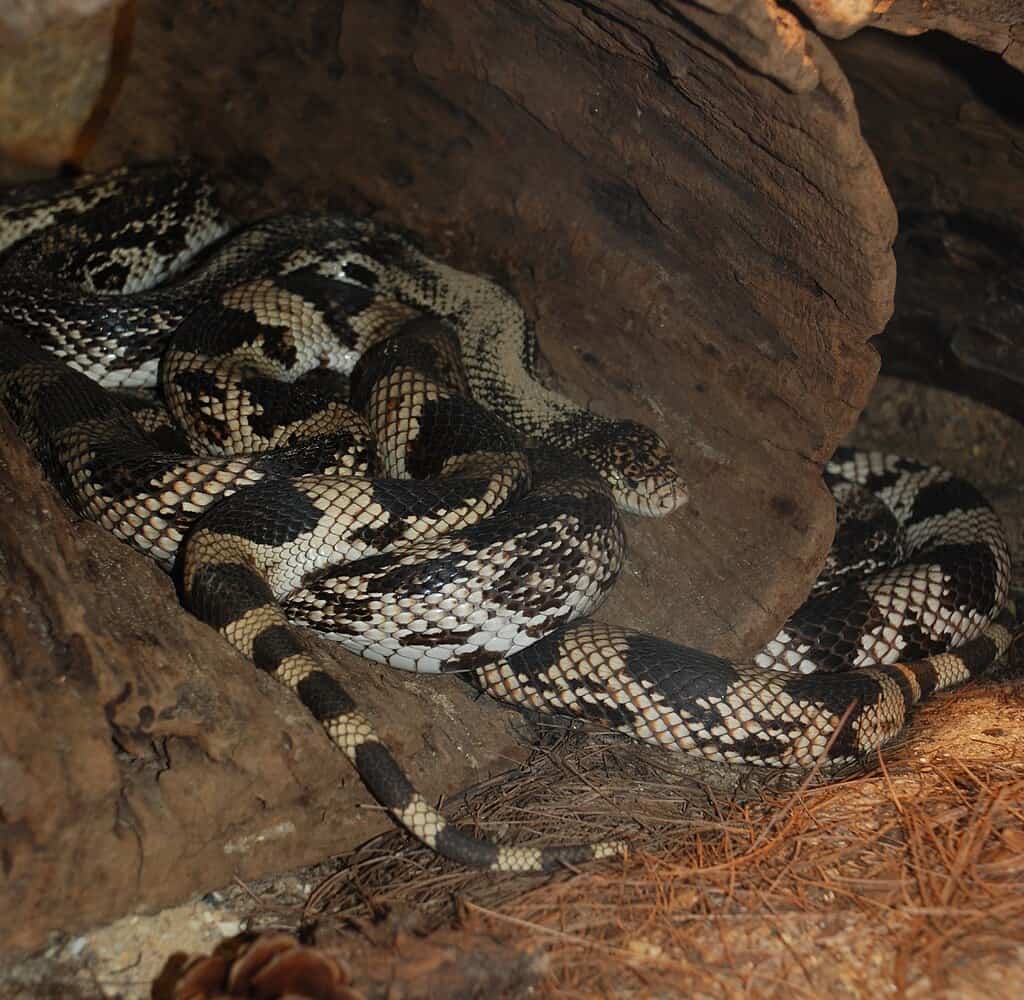
The pine snake (Pituophis melanoleucus) is a large species of the eastern US, appearing in states such as Florida, Georgia and North Carolina. They’re a non-venomous constrictor which is aggressive towards humans, but doesn’t meet them particularly often.
At an average of 120-200cm, and an all-time record of 228.6cm, this is one of the USA’s largest snakes. Pine snakes are usually found in wooded realms like longleaf pine, scrub oak, turkey oak and pine barrens, but rather than climbing branches, their favourite direction to travel is downwards.
More than any US snake, pine snakes are notorious for their underground habits. They don’t just take over existing burrows, but create elaborate networks of underground tunnels, forged using their superior digging abilities. They both hibernate and lay eggs in these tunnels, and specifically select habitats with softer soils for easier digging.
Pine snakes can be faithful to the same underground den for years, venturing away to hunt during summer, before retracing their steps to the dark entrance in November. They also return to their dens sometimes during summer, particularly in hot weather.
To accomplish these feats, pine snakes have a special snout, with an enlarged rostral scale that allows them to effortlessly shift aside debris. They also have a strategic brain, as they tend to follow the lines of old tree roots when digging.
| 2 | Digs tunnels 6 metres long |
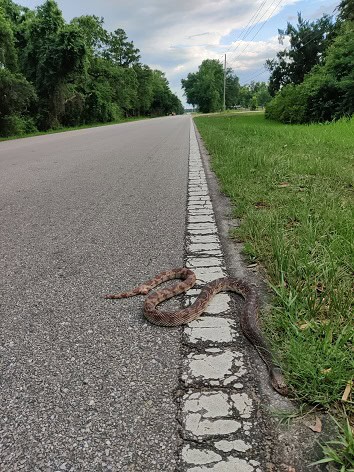
Pine snakes both dig their own burrows and take over existing ones. The entrance typically looks like a small dark hole, but on the inside lies an elaborate network of tunnels with many chambers. Pine snakes are able to follow the scents of their fellow kind to locate underground dens, and distinguish between species members and dangerous predators.
The pile of excavated earth outside a pine snake den can be 2 or 3 feet wide. Compared to Florida or Mississippi, those further north (e.g. New Jersey) tend to excavate longer, much deeper chambers. By adding to existing mammal tunnels and adding new side tunnels, pine snakes can create underground dens 6 metres long, and 1.2 metres underground vertically.
If a den is particularly grand and cosy, then multiple pine snakes can congregate at once. Scientists have found up to 33 pine snakes in one underground chamber, and unrelated species like corn snakes, black racers and hognose snakes can also flock to these refuges, creating a peaceful communal hibernacula. These dens have mainly been found in the northern realms like New Jersey. By contrast, Florida pine snakes tend to hibernate singly, as there’s less need to huddle together and preserve warmth.
| 3 | Non-venomous yet vicious |
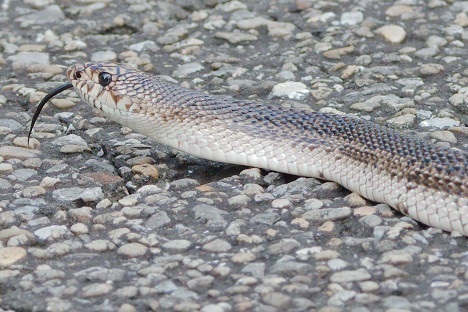
If you wish to search for pine snakes in your local oak forest, there’s a good chance that you’ll walk right over their heads. However, they’re not that difficult to find, as they don’t spend their entire lives underground like blind snakes.
Pine snakes are a diurnal species, moving by day. If encountered by a human, they can rapidly turn vicious. Pine snakes are non-venomous constrictors, but have sharp fangs which can easily tear skin. A pine snake’s reaction is to throw itself into an s-shape similarly to a rattlesnake. They then hiss as a warning, but also unleash one of the snake kingdom’s weirdest noises, a bellowing growl. This is partially created by a modified glottis in their throat, and has unique harmonic elements according to a 1995 study. Gopher snakes further west can also produce this odd noise.
If the intruder refuses to leave, then the pine snake will launch a real, not feigned strike. Unlike a hognose snake, they won’t give up and start faking death. Pine snakes have every intention of biting human skin and drawing blood. They make wide, sweeping strikes, to add to the air of unhinged aggression.
| 4 | Nemesis: red fox |
Pine snakes have a highly flexible diet. Their focus is on mammals, but they also prey on birds and reptiles. Many dietary items are inhabitants of the burrows and tunnels they enter, including gopher tortoises and Mazama pocket gophers. Owls are surprisingly popular with pine snakes, including western screech owls and elf owls.
Despite exceeding 2 metres, and being a muscular constrictor which exerts brutal squeezing force, pine snakes have a long list of predators in their pine-oak habitats. Several of these are intelligent enough to locate their underground dens and assault the sleeping snakes within, including American red foxes, striped skunks, and northern short-tailed shrews.
A 5 year study from 1989-1994 examined pine snake nest dens in New Jersey’s pine barrens. Of 201 dens, 44 were dug up for eggs by red foxes, and 7 by skunks. 5 pine snakes were killed by short-tailed shrews over the study, one by a fox, and two by striped skunks. More disturbingly, 29% of nests followed from 1988-1990 were dug up by human poachers, searching for eggs to steal (and probably sell).
| 5 | Egg thief: scarlet snake |
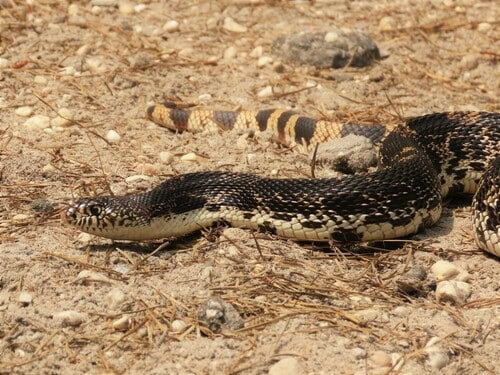
Pine snakes are also preyed on by-red tailed hawks, America’s most infamous ophiophagous bird, which also preys on the nearby eastern ratsnake. As for fellow serpents, scarlet snakes have been observed puncturing pine snake eggs with their enlarged front teeth, before drinking the white and yolk inside.
The common kingsnake (Lampropeltis getula) is another confirmed predator. In fact, a 1989 study found that pine snakes deliberately avoided travelling over ground that had been smeared with kingsnake scents. Likewise, hatchlings refused to enter a laboratory maze that had been smeared with red fox scents. The fact that hatchlings were sensitive shows that this is a genetic feature, that pine snakes have adapted to this predator potentially for millions of years, in the formerly untouched American wilderness.
Other confirmed predators include Swainson’s hawks and golden eagles. One reason why they’re vulnerable is their tendency to nest in open fields. While they stick to sandy forests and bushy margins normally, shielding them from vegetation, they move to relatively treeless areas to construct their nest burrows (or find and enlarge an existing burrow). It’s almost certain that red foxes too recognize pine snake scents, just as they recognize there’s.
| 6 | Can move 1000 metres in a day |
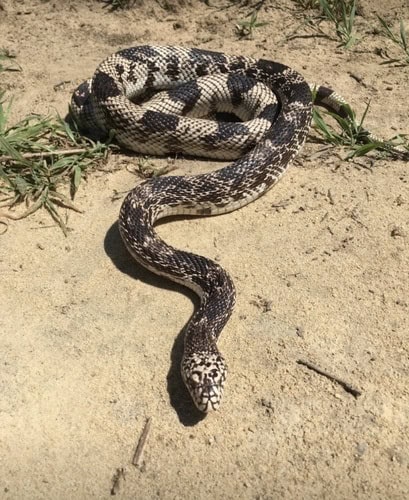
Pine snakes are known for their large home ranges, that cover several hundred acres. Males can migrate huge distances in pursuit of females, lured on by tantalising scents. Some radio-tracked pine snakes have travelled over 2 miles in an entire day. Despite this adventurousness, they’re still able to return to their home burrow on time in November or October (depending on climate).
According to a 2009 study, pine snakes become less active during the height of summer. Their activity had two peaks: spring and late summer to autumn. 9 pine snakes were implanted with radio-trackers, and it was discovered that they averaged at 273 metres per movement.
The single largest move in a day was 1221.4 meters, accomplished by a male on May 15th 2001. Another male managed to travel 557.2 meters in 4.5 hours, while the longest female distance travelled was 886.0 meters on August 1st 2001. The study was conducted in Tennessee’s Arnold Air Force Base (AFB), an abandoned WW2 military installation which has now been reclaimed by nature. One characteristic was the remains of concrete building foundations scattered around the reserve, and the pine snakes eagerly took advantage of cracks in these for hibernation dens. All pine snakes tracked entered hibernation between October 14th and November 11th.
| 7 | Habitat: open forests with dry soil |
Pine snakes are relatively slow-moving snakes, yet are persistent and relentless, ultimately travelling large distances. Hence, roads between dry woodlands are the most likely place for a layman to find them, similarly to hognose snakes.
Pine snakes are rarely found near swamps or marshes. In fact, this is one of the least likely snakes in the USA to find swimming. As for forests, they tend to avoid dense, closed canopy forests, as the lack of sunlight keeps the soil too moist. They prefer spacious, open forests with dry soils. Hence, you’re unlike to find them alongside a timber rattlesnake or copperhead, despite the three sharing a large range in the eastern USA. You’re more likely to find them rubbing shoulders with a southern hognose snake, another woodland burrower, which also enjoys dry soils for burrowing.
Pine snakes sometimes steal the hibernacula of fellow species members; for example, a female was found to occupy a male’s burrow after he left, and use the empty tunnels as an egg chamber. When excavating burrows, scientists have found egg shells clearly from different years, proving their faithfulness to one burrow. Their eggs have also been collected under shingle piles and even below an old mattress.
| 8 | Territory of the pine snake |
Pine snakes have been recorded from 13 states overall, with the most plentiful sightings in Florida, Georgia and North Carolina. However, they’re ultra rare in West Virginia, with only a single confirmed sighting (Monroe County) in 1940 in the form of roadkill. Likewise, records are very scarce in Virginia and Kentucky.
Meanwhile, the New Jersey populations are a fully separated pocket to the north, as pine snakes have never been encountered in Maryland or Delaware to the south. Despite being isolated, sightings are plentiful here, as they’re confined to the New Jersey Pine Barrens, a vast area of rural, undisturbed land containing remnant Atlantic pine forests, with a thriving ecosystem. This lies southeast of Philadelphia, and contains the protected Pinelands National Reserve, a land of sandy soil which is poor for agriculture, but perfect for pine snakes.
Technically, eastern Texas and western Louisiana also contain pine snakes, but this is a fully independent species. The Louisiana pinesnake (Pituophis ruthii) is severely endangered, as it occurs only in longleaf pine forests, and only in pocket gopher burrows, making it far less flexible even compared to normal pine snakes.
| 9 | 3 subspecies |
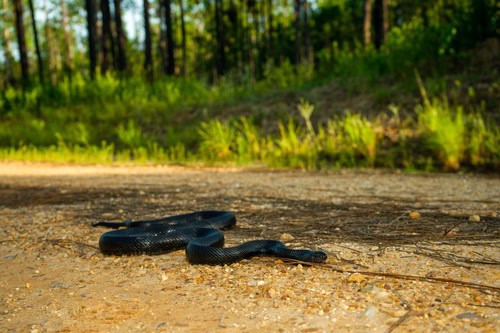
Louisiana pinesnakes are a separate species, but the real pine snake has 3 official subspecies. The first is the northern pine snake (Pituophis m. melanoleucus), which is the only subspecies found in New Jersey. They also inhabit the Carolinas, Georgia, Tennessee and Alabama. This is the most strongly black and white subspecies, with vividly contrasting blotches, except newborns prior to shedding their skin. Some even have bright orange, red or purple spots on their lower body, making them highly prized with collectors.
The westernmost, and rarest subspecies is the black pine snake (Pituophis m. lodingi). This version is usually black from head to toe, with even their belly a uniform black. However, a few have occasional white bands, and their face has a smattering of red. This version inhabits the 4-way border zone between Mississippi, Alabama, Louisiana and far western Florida.
Finally, the Florida pine snake (Pituophis m. mugitus) is the dullest of three. This inhabits most of Florida, except the far south (such as the everglades). They also inhabit South Carolina, Alabama and Georgia. This subspecies is often a murky beige-brown, with the blotches much less distinct and vivid Around the neck, the blotches often blend together completely. However, a few individuals have vivid black-white colours closer to the northern subspecies. There’s also various areas where the subspecies blend together, such as Georgia.
| 10 | Capable of living 20 years |
Pine snakes are a true constrictor, applying several coils to crush their prey to death. However, smaller prey like juvenile rodents are swallowed alive, without constriction. One of the pine snake’s most brutal tendencies is to invade underground burrows, and swallow nestling mice while they sleep. Here, they’re too constrained to constrict properly, and default to pinning prey against underground walls instead.
Pine snakes reach decent ages, with the record being a female held at San Diego Zoo who reached 20 years, 9 months, and 2 days old. Their clutch size varies, with a range of 3-24, but an average of eight. Their eggs are unusually large, and so are the hatchlings, at an average of 30-45cm.
Despite the effort they take to construct underground dens, Louisiana pinesnakes aren’t known to guard their young. Intubation of the eggs lasts for 73 days on average, with eggs typically hatching in August or September. When a male pine snake catches up with a female, he sometimes bites her neck to prevent her escape.
